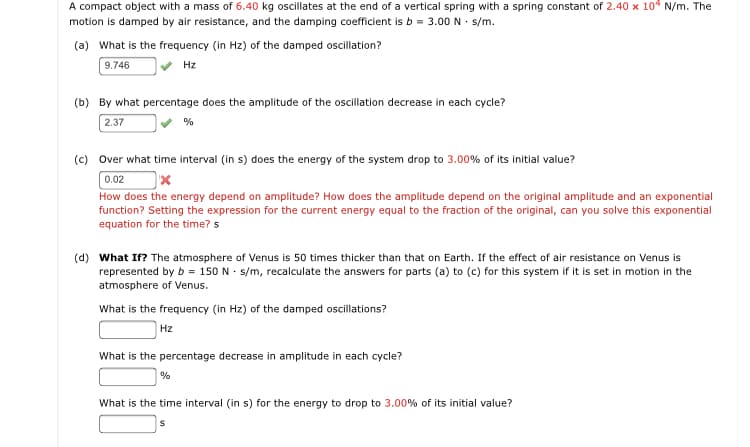A compact object with a mass of 6.40 kg oscillates at the end of a vertical spring with a spring constant of 2.40 x 10 N/m. The motion is damped by air resistance, and the damping coefficient is b = 3.00 N - s/m. (a) What is the frequency (in Hz) of the damped oscillation? 9.746 Hz (b) By what percentage does the amplitude of the oscillation decrease in each cycle? 2.37 (c) Over what time interval (in s) does the energy of the system drop to 3.00% of its initial value? 0.02 How does the energy depend on amplitude? How does the amplitude depend on the original amplitude and an exponential function? Setting the expression for the current energy equal to the fraction of the original, can you solve this exponential equation for the time? s (d) What If? The atmosphere of Venus is 50 times thicker than that on Earth. If the effect of air resistance on Venus is represented by b = 150 N - s/m, recalculate the answers for parts (a) to (c) for this system if it is set in motion in the atmosphere of Venus. What is the frequency (in Hz) of the damped oscillations? Hz What is the percentage decrease in amplitude in each cycle? % What is the time interval (in s) for the energy to drop to 3.00% of its initial value?
A compact object with a mass of 6.40 kg oscillates at the end of a vertical spring with a spring constant of 2.40 x 10 N/m. The motion is damped by air resistance, and the damping coefficient is b = 3.00 N - s/m. (a) What is the frequency (in Hz) of the damped oscillation? 9.746 Hz (b) By what percentage does the amplitude of the oscillation decrease in each cycle? 2.37 (c) Over what time interval (in s) does the energy of the system drop to 3.00% of its initial value? 0.02 How does the energy depend on amplitude? How does the amplitude depend on the original amplitude and an exponential function? Setting the expression for the current energy equal to the fraction of the original, can you solve this exponential equation for the time? s (d) What If? The atmosphere of Venus is 50 times thicker than that on Earth. If the effect of air resistance on Venus is represented by b = 150 N - s/m, recalculate the answers for parts (a) to (c) for this system if it is set in motion in the atmosphere of Venus. What is the frequency (in Hz) of the damped oscillations? Hz What is the percentage decrease in amplitude in each cycle? % What is the time interval (in s) for the energy to drop to 3.00% of its initial value?
Related questions
Question
100%

Transcribed Image Text:A compact object with a mass of 6.40 kg oscillates at the end of a vertical spring with a spring constant of 2.40 x 104 N/m. The
motion is damped by air resistance, and the damping coefficient is b = 3.00 N · s/m.
(a) What is the frequency (in Hz) of the damped oscillation?
9.746
Hz
(b) By what percentage does the amplitude of the oscillation decrease in each cycle?
2.37
%
(c) Over what time interval (in s) does the energy of the system drop to 3.00% of its initial value?
0.02
How does the energy depend on amplitude? How does the amplitude depend on the original amplitude and an exponential
function? Setting the expression for the current energy equal to the fraction of the original, can you solve this exponential
equation for the time? s
(d) What If? The atmosphere of Venus is 50 times thicker than that on Earth. If the effect of air resistance on Venus is
represented by b = 150 N · s/m, recalculate the answers for parts (a) to (c) for this system if it is set in motion in the
atmosphere of Venus.
What is the frequency (in Hz) of the damped oscillations?
Hz
What is the percentage decrease in amplitude in each cycle?
What is the time interval (in s) for the energy to drop to 3.00% of its initial value?
Expert Solution
This question has been solved!
Explore an expertly crafted, step-by-step solution for a thorough understanding of key concepts.
This is a popular solution!
Trending now
This is a popular solution!
Step by step
Solved in 2 steps
